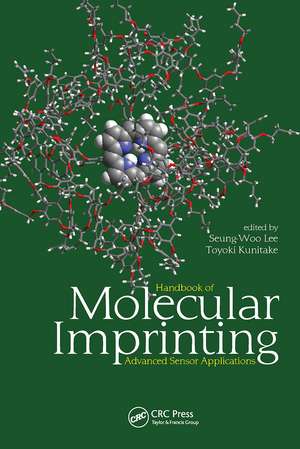Handbook of Molecular Imprinting: Advanced Sensor Applications
Editat de Seung-Woo Lee, Toyoki Kunitakeen Limba Engleză Hardback – 18 sep 2012
A collection of contributions from distinguised experts, Handbook of Molecular Imprinting: Advanced Sensor Applications provides a comprehensive overview on the specific challenges of molecular imprinting in sensor applications. It covers various molecular imprinting approaches. As a result, a perspective of future device ensembles for sensing is acquired. The text lays particular emphasis on fundamental aspects as well as novel ideas in the context of sensor applications. It also highlights the operation principles of various sensor transducers that are generally employed in combination with molecular imprinting recognition elements.
Preț: 1080.59 lei
Preț vechi: 1447.91 lei
-25% Nou
Puncte Express: 1621
Preț estimativ în valută:
206.79€ • 224.55$ • 173.71£
206.79€ • 224.55$ • 173.71£
Comandă specială
Livrare economică 01-15 aprilie
Doresc să fiu notificat când acest titlu va fi disponibil:
Se trimite...
Preluare comenzi: 021 569.72.76
Specificații
ISBN-13: 9789814316651
ISBN-10: 9814316652
Pagini: 500
Ilustrații: 203 b/w images and 13 color images
Dimensiuni: 152 x 229 x 38 mm
Greutate: 1.02 kg
Ediția:1
Editura: Jenny Stanford Publishing
Colecția Jenny Stanford Publishing
ISBN-10: 9814316652
Pagini: 500
Ilustrații: 203 b/w images and 13 color images
Dimensiuni: 152 x 229 x 38 mm
Greutate: 1.02 kg
Ediția:1
Editura: Jenny Stanford Publishing
Colecția Jenny Stanford Publishing
Public țintă
Academic and PostgraduateCuprins
Fundamentals and Perspectives of Molecular Imprinting in Sensor Applications. Molecularly Imprinted Sensing Receptors. Translational Applications of Molecularly Imprinted Polymer-Based Electrochemical Sensors. Optical Sensors for Monitoring Inorganic Toxins. 5 MIP Thermistor. The Use of a Thermally Reversible Bond for Molecular Imprinting. Molecular-Sieving Silica/Tin Oxide Sensor Prepared by Chemical Vapor Deposition in the Presence of Template Molecule. Environmental Approaches by Molecular Imprinting on Titanium Dioxide. Molecularly Imprinted Nanocomposites for Highly Sensitive SPR Detection. Molecularly Imprinted Room Temperature Phosphorescent Optosensors for Environmental Pollutants. Electrochemical Sensing of Nitro-Aromatic Compounds in Natural Waters and Soil Samples. Trace Detection Based on Cyclodextrin-anchored Molecularly Imprinted TiO2 Thin Films. Molecularly Imprinted Au Nanoparticles Composites and Their Application for Sensing, Controlled Release, and Photoelectrochemistry. Protein-Sensing Using Organic/Inorganic Hybrid Materials Prepared by Liquid Phase Deposition-Based Molecular Imprinting. Molecular Imprinted Polymer-Based Chemiluminescence Sensors. Detection of Cells and Viruses Using Synthetic Antibodies. Molecularly Imprinted Polymers: Science Goes Market? — A Market Analysis Based on the Patent Situation.
Recenzii
"This book represents an extensive collection of essential fundamentals of molecular imprinting and state-of-the-art technologies of its sensor applications. It describes various bio- and chemo-sensing methods using molecular imprinting and will be of great interest to students and researchers in chemistry, physics, and materials science."
—Prof. Kiyoshi Toko - Kyushu University, Japan
"Sensors that memorize the shape and size of molecules can detect all targets. Such an ultimate concept of sensing has been realized by molecularly imprinted sensors. This handbook excellently presents the features of these sensors."
—Prof. Katsuhiko Ariga - National Institute for Materials Science, Japan
—Prof. Kiyoshi Toko - Kyushu University, Japan
"Sensors that memorize the shape and size of molecules can detect all targets. Such an ultimate concept of sensing has been realized by molecularly imprinted sensors. This handbook excellently presents the features of these sensors."
—Prof. Katsuhiko Ariga - National Institute for Materials Science, Japan
Descriere
This book is probably the first attempt to gather together contributions of distinguished experts to provide a comprehensive overview on the specific challenges of molecular imprinting in sensor applications. Different molecular imprinting approaches are covered, and, as a result, a perspective of future device ensembles for sensing is acquired. Particular emphasis has been laid on fundamental aspects as well as novel ideas in the context of sensor applications. The book starts with brief introduction to basic principles of available imprinting approaches based on organic and inorganic matrices. The operation principles of various sensor transducers that are generally employed in combination with molecular imprinting recognition elements are highlighted. The book is divided according to the purpose of applications on different sensors and transducers (e.g., mass-sensitive, electrochemical, and optical).
